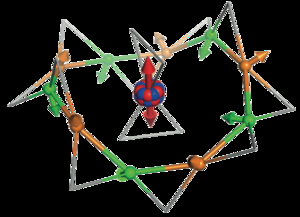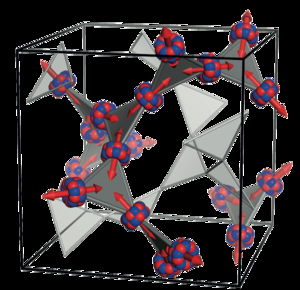Unusual novel states in a single-crystal gadolinium gallium garnet

When a material undergoes a phase transition from a disordered to an ordered state, its properties change and these changes are observed via macroscopic observables such as specific heat capacity measurements.
Indeed the typical signature of a phase transition is a local maximum in the temperature dependence of the specific heat capacity. However a specific heat capacity measurement only indicates the existence of a phase transition, not the microscopic origin. One of the greatest triumphs of twentieth-century physics was to explain these macroscopic changes observed in bulk measurements, such as heat capacity, in terms of the microscopic ordering of atoms, electrons and their magnetic moments. Neutron scattering techniques developed since the 1950's have provided us with a dazzling array of ordered magnetic structures. A well -known example is that of antiferromagnetism with magnetic moments alternating between pointing up and down on adjacent atoms. Until 1940 macroscopic bulk measurements showed the existence of a phase transition, yet no direct measurement of the microscopic properties could be made. This changed in the 1950's, when neutron scattering techniques were used to finally prove the existence of antiferromagnetic order via the spatial information that neutron scattering affords.
A similar situation exists today. There are many materials for which there is weak evidence of a macroscopic reordering yet no microscopic explanation can be found:, a hidden order. In the compound studied, Gd3Ga5O12, the magnetic ions sit on a complex triangular lattice, a hyperkagome. This compound has perplexed condensed matter physicists for decades, principally because no signature of magnetic order had been observed down to 25 mK. We show that weak features in the bulk measurements are consistent with long- range magnetic order, derived from an emergent ordering of ten ions on a looped structures, decagons. The resultant magnetic order of each decagon loop, a spin director, is highly structured and correlated between the decagon loops. Indeed on a local level the system looks disordered, and yet there is a clearly defined order at a larger scale, a situation very much reminiscent of nematic ordering in molecular structures. Developments in Reverse Monte Carlo computing, concomitant with demanding neutron scattering measurements on a single crystal of non-isotope enriched Gd3Ga5O12, using D9 at the ILL, resulted in the discovery of these unusual novel states.

The work could only be achieved due to the unique short-wavelength capability and high neutron flux of D9 at ILL. It is a collaboration between the Universities of Copenhagen, Oxford, and Warwick, the ESS, and the ILL.
Provided by Institut Laue-Langevin




















